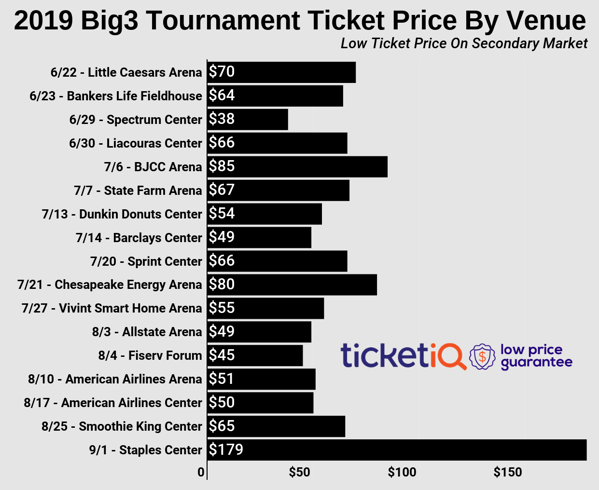How To Find Cheapest 2019 Big3 Basketball Tickets
June 17, 2019
The Big3 basketball league is set to begin its third season this week. The average asking price for a ticket on the secondary market is $110 compared to $84 last year and $109 when the league debuted. Unsold face value tickets are available for most cities via Ticketmaster, with more expensive tickets sold out in a several markets. As a result, it's important to look for face price tickets as well as sold out secondary market tickets. The most expensive ticket on the secondary market is for the championship game at the Staples Center. Below are the cheapest tickets at each of the venues on the Secondary ticket market.

As the above image shows, most cities have tickets on the secondary ticket market starting around $50. TicketIQ also has low price guarantees on all sports tickets, which means that if you find a secondary market ticket for less on a site like Stubhub or Seatgeek, we’ll give you 200% of the difference in ticket credit. TicketIQ customers save up to 25% compared to Stubhub and Vivid Seats. For fans looking to go big for the Big3, courtside seats have a face price of $1,000, but are available only on Ticketmaster. Download the TicketIQ app for $20 off your first ticket purchase 📲 🎟️
Big3, a 3-on-3 basketball league featuring retired NBA players, opens tonight at Houston’s Toyota Center. For the season, tickets across the board are cheaper on the primary market. The BIG3 recently expanded from eight teams to 12 teams for the 2019 season. The league has also added former NBA stars such as Gilbert Arenas, Lamar Odom, Greg Oden and Kendrick Perkins to the talent pool for its third season. According to a press release issued, the league will be getting serious TV exposure: "During the upcoming 11-week BIG3 season, games will air live on CBS Television Network and CBS Sports Network on both Saturdays and Sundays, with a champion crowned live on CBS on Sunday, September 1. CBS Television Network will broadcast more than 20 hours throughout the season, with CBS Sports Network set to televise more than 25 hours of additional live game coverage."
Below is the full 2019 Big 3 schedule
- June 22 — Detroit (Little Caesars Arena)
-
June 23 — Indianapolis (Bankers Life Fieldhouse)
-
June 30 — Philadelphia (Liacouras Center)
-
July 6 — Birmingham (Legacy Arena at the BJCC)
-
July 7 — Atlanta (State Farm Arena)
-
July 13 — Providence (Dunkin Donuts Center)
-
July 21 — Oklahoma City (Chesapeake Energy Arena)
-
August 3 — Chicago (Allstate Arena)
-
August 18 — San Antonio (AT&T Center)
Below are Big3 rules for anyone considering checking it out.
- Like FIBA-sanctioned 3x3, games are played on a half-court.
- Standard two- and three-point shots apply; the three-point line is the same distance as in the NBA. (3x3 uses the FIBA arc, with shots from outside the arc worth 2 points and all others worth 1.)
- Unique to Big3 are three "four-point zones" on a circle 30 feet away from the basket. One is on the midline of the court; the other two are 40 degrees away from the midline. To score four points, a player's foot must be touching any part of a circle.
- Instead of a jump ball to start the game, the "home" team inbounds first. The home team is determined by a do-or-die 4-point shootout. Compare with 3x3, in which the first possession is determined by a pregame coin toss, with the winner choosing whether to take possession at the start of a game or the start of a potential overtime.
- The shot clock runs 14 seconds, as opposed to 12 in 3x3.
- Additional free throw is taken if a player is fouled while making a shot.
- A shooting foul awards one free throw, worth the same number of points as the fouled shot. Two-point shots are taken from the free throw line, three-point shots from the three-point line, four-point shots from the midline four-point circle. The free throw is awarded whether or not the fouled shot hits the basket. 3x3 follows standard FIBA rules for free throws after shooting fouls, with the exception of bonus situations (see next item). Normally, if the basket attempt was made, one free throw is awarded, and if the basket attempt was missed, a number of free throws equal to the value of the shot attempt is awarded. Additionally, all free throws in 3x3 are worth 1 point, as they are in standard full-court basketball.
- Similar to 3x3, fouls are ascribed to the team; players cannot foul out. However, the bonus free throw rules differ between the two rule sets. In Big3, after the fifth team foul in each half, opponents are guaranteed two one-point free throws and possession of the ball. Teams do not enter the bonus in 3x3 until the 7th team foul in a game, at which point the non-fouling team receives two free throws, but not possession. Only on the 10th team foul does the non-fouling team receive two free throws and possession. Under FIBA 3x3 rules, the normal rules for free throws on shooting fouls are specifically superseded by the bonus rules.
- A team's first technical foul results in one two-point free throw and possession. Additional technical fouls, as well as all flagrant fouls, result in two two-point free throws and possession. In 3x3, fouls classified as "technical" result in one (1-point) free throw and possession during open play, and "unsportsmanlike" fouls (essentially the same as "flagrant" fouls in Big3) result in two free throws and possession.
- To win, a team must score 50 or more points, and lead by at least two points (hence there is no overtime). In 3x3, the game ends by rule after 10 minutes of play, or if a team reaches at least 21 points, with no required victory margin. If the teams are tied, 3x3 uses an untimed overtime with the shot clock enforced, and the first team that scores 2 points in the overtime wins.
- Halftime happens after one team reaches 25 points. 3x3 has only a single period of 10 minutes.
- Each team receives two timeouts—a 60-second and a 30-second—per half. Unused timeouts do not carry over. 3x3 allows only one timeout per team.
- Substitutions can be made on a dead ball or by calling a timeout.
- After a score, a referee must touch the ball. After giving the defense 3 seconds to set, the opposing team must take the ball beyond the top out-of-bounds line. Player has 5 seconds to return the ball inbounds. In 3x3, a referee is not required to be involved in a change of possession after the score. Instead, the non-scoring team takes possession of the ball directly under the basket, and at that point is free to dribble or pass the ball, but no shot is legal until the ball has been cleared beyond the arc.
- Defensive rebounds must be cleared if the ball touched the rim. If the ball did not touch the rim, defensive rebounds do not need to be cleared. In 3x3, all defensive rebounds must be cleared.
- Steals do not have to be cleared, unlike in 3x3.
- The ball is cleared when the player with the ball establishes both feet behind the 3-point line. The ball can be cleared by dribbling or passing. This rule is identical to 3x3.
- A defensive rebounder who makes a direct pass that clears the ball must clear the lane and re-establish himself before his team's shot or pass hits the rim.
- If, following a defensive rebound after the ball touches the rim, the rebounding team shoots or passes before clearing the ball and the ball hits the rim, it results in a turnover. This rule is identical to 3x3, and in that variant also extends to all changes of possession.
- Once a team has cleared the ball and establishes itself on offense, the normal "3 seconds in the key" rule applies.
- There is no defensive "3-second" rule, unlike in 3x3.
- Instant replay applies and can be used to determine 3 and 4-point shots, out-of-bounds, flagrant fouls, goaltending, basket interference and clearance.
- All defensive strategies are allowed, including hand-checking, which is banned in the NBA.[9]
- The ball used is the same size 7 ball used in the men's full-court game (standard circumference 29.5 in/75 cm, standard weight 22 oz/620 g). All adult 3x3 competitions, whether for men, women, or mixed teams, use a ball unique to that game. The weight is the same as that of a size 7 ball, but the circumference is that of the size 6 ball (28.5 in/72 cm) used in the women's full-court game.

